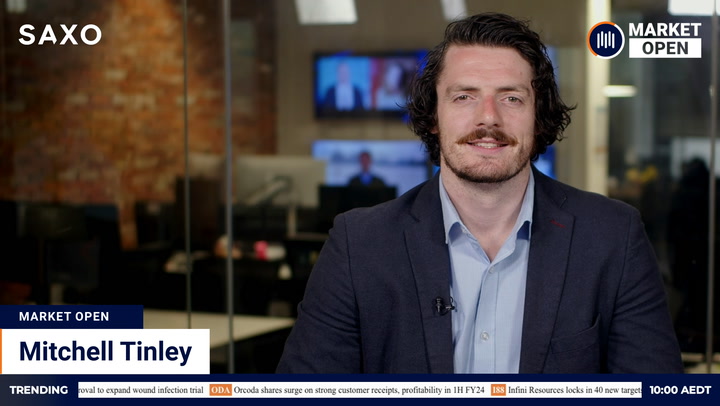A new month was set for a rough start after Wall Street’s worst session since 2020 drove the major indices to new lows for the year.
ASX futures skidded 94 points or 1.27 per cent, signalling a resumption of selling pressure after a two-day rebound.
Gains in iron ore, Brent crude, gold and copper may provide some support. The dollar traded below 71 US cents, near its weakest level since early February.
Wall Street
US stocks tumbled as weak outlooks from Amazon and Apple and fresh inflation data added to investors’ worries. Tech stocks led an accelerating sell-off that expanded to include all 11 sectors.
The Nasdaq Composite plunged 537 points or 4.17 per cent. The S&P 500 shed 156 points or 3.63 per cent. The Dow Jones Industrial Average lost 939 points or 2.77 per cent. Losses for all three were the heaviest since 2020.
Amazon, America’s third-largest listed company, fell 14.05 per cent to a two-year low after reporting an unexpected loss. While much of the quarterly loss was attributable to its investment in electric truck maker Rivian, the retail giant’s revenue forecast was well short of Wall Street expectations.
Apple added to concerns about valuations of the pandemic’s biggest winners after warning supply-chain issues could dent revenues. The share price eased 3.66 per cent. Intel’s guidance also disappointed, sending its shares down 6.94 per cent.
The first-quarter reporting season has been generally better than expected, but investors have punished companies on signs of weakness, particularly those whose earnings appear most at risk from higher rates. The Federal Reserve meets this week and is expected to raise its target rate by up to 50 basis points on Wednesday.
Inflation data added to pressures on the Fed to raise. Headline annual inflation accelerated to a four-decade high of 6.6 per cent in March from 6.4 per cent the previous month, according to the PCE price index. Core inflation eased to 5.2 per cent from 5.3 per cent, but remained elevated.
Friday’s declines completed a horror month for investors. The Nasdaq Composite lost 13 per cent, its worst return since the GFC. The S&P 500 shed 8.8 per cent and the Dow 4.9 per cent, their biggest hits since the initial pandemic sell-off in 2020.
“The current market performance is threatening to make a transition from a longish and painful ‘correction’ to something more troubling,” Michael Shaoul, Marketfield Asset Management Chairman, wrote.
“The current episode… is best thought of a ‘creeping bear market,’ that is steadily widening its net over prior market leadership,” Shaoul added.
The Nasdaq Composite finished the month 23.9 per cent below last year’s peak. The S&P 500 and Dow were both in technical corrections, down more than 10 per cent from their highs. The S&P 500 has fallen 14.3 per cent and the Dow 10.8 per cent.
Australian outlook
Heavy selling across the Anzac Day long weekend looks set to resume after a brutal end to the US trading month. The S&P/ASX 200 ended April with a two-day bounce that looks ill-judged in the light of Friday’s events.
All 11 US sectors slumped. Falls ranged up to an eye-watering 5.92 per cent for the consumer discretionary sector, which is dominated by Amazon. Real estate shed 4.9 per cent, tech 4.14 per cent and communication services 3.58 per cent.
Investors looking for cause for optimism this session might draw relief from the fact the US materials sector was the best of a bad bunch with a loss of 1.97 per cent. Energy was next best, down 2.47 per cent.
Central bank meetings dominate the outlook for the week ahead. Tomorrow’s RBA rates decision is the highlight of a crowded domestic calendar. Tuesday’s meeting is the first in several years where there is genuine doubt over the outcome.
A Reuters poll showed the median consensus among economists was for an increase to the cash rate of 15 basis points. However, significant minorities favoured no change or a chunkier increase of 40 basis points. Any result has the potential to create fireworks.
“While a 40bp hike is warranted, to limit the fallout in the lead up to the Federal Election, the RBA will likely raise rates by 15 bps on Tuesday, taking the cash rate to 0.25%, before lifting rates to 1.5% by year-end,” Tony Sycamore, Senior Market Analyst at City Index, said.
“The RBA’s decision on Tuesday has the potential to move the local equity market and the currency market in the short term,” he added. “In the medium-term, larger macro forces remain the driver, including the war in Ukraine, Chinese Covid lockdowns, commodity, energy prices, inflation, and Federal Reserve rate hikes.”
On Wednesday, the US Fed is expected to lift its target rate by 50 basis points as the battle to bring down inflation begins in earnest. The announcement will come early Thursday morning, Australian time.
Also on the domestic economic calendar this week: April job ads, inflation gauge (today); weekly consumer confidence (Tuesday); March retail sales, April construction data (Wednesday); March building approvals, trade balance (Thursday); and the RBA’s quarterly monetary policy (Friday).
The May “mini AGM” season gets underway this week with meetings for shareholders in Santos and TPG Telecom (Tuesday); and Rio Tinto, QBE, Iress and Ventia Services Group (Thursday).
IPOs: the market’s push back towards record levels last month has encouraged a few more companies to take the plunge. There are seven companies under starter’s orders this week, including three today.
Solstice Minerals at 11 am AEST is a spin-off from OreCorp with gold projects in WA. Allup Silica at 11.30 am is an explorer focussed on silica sand tenements in WA. Sarama Resources at 12.30 pm is a West African gold developer with an existing listing in Canada.
The rest of the week currently looks like this: Equity Story Group, Sierra Nevada Gold (Tuesday); Koba Resources (Wednesday); and Chrysos Corporation (Friday).
The quarterly reporting season just finished produced most of last week’s major winners and losers. Retailer City Chic Collective was the index’s best performer with a gain of 12.4 per cent. Also strong were Nickel Mines +11 per cent and Sandfire Resources +5.7 per cent.
The worst performers were EML Payments -41 per cent, Life360 -23.1 per cent and Silver Lake Resources -12.3 per cent.
The dollar bounced 0.55 per cent this morning to 70.72 US cents.
Commodities
Chinese support for its struggling economy helped keep a floor under commodity prices despite turmoil on equity markets. President Xi Jinping chaired a Politburo meeting where the government announced it would roll out measures to help industries affected by the pandemic.
“We should accelerate the implementation of policies, implement tax rebates, tax and fee cuts and other policies, and make good use of all kinds of monetary policy tools,” the Politburo said in a statement after the meeting.
Iron ore prices rallied on expectations the measures will include infrastructure spending, sharpening demand for steel. Benchmark ore on the Dalian Commodity Exchange climbed 4.2 per cent to 870 yuan (US$132.05) a tonne.
Benchmark copper on the London Metal Exchange rose 0.8 per cent to US$9,770 a tonne. Aluminium improved 0.6 per cent, lead 0.2 per cent and tin 0.3 per cent. Nickel gave up 3.7 per cent and zinc lost 1.1 per cent.
“We have some positive news from China’s Politburo which pledged more measures to spur economic growth because the economy has been struggling,” ING analyst Wenyu Yao wrote.
The news helped cushion Australia’s mining heavyweights from the worst of Friday’s Wall Street selling. BHP‘s US-traded depositary receipts eased 1.66 per cent. Earlier, the miner’s UK stock firmed 0.87 per cent. Rio Tinto shed 0.55 per cent in the US after gaining 1.39 per cent in the UK.
Oil benchmarks were mixed. Brent crude rose for a fourth day; the US benchmark was dragged down by the risk-off mood on equity markets. Brent crude settled US$1.75 or 1.6 per cent ahead at US$109.34 a barrel. West Texas Intermediate fell 67 US cents or 0.6 per cent to US$104.69.
Gold trimmed a losing month as a fierce rally in the US dollar cooled. Metal for June delivery settled US$20.40 or 1.1 per cent ahead at US$1,911.70 an ounce. The recovery pared the yellow metal’s April loss to 2.1 per cent, its worst performance since September.
The NYSE Arca Gold Bugs Index succumbed to the general selling, falling 1.18 per cent.





